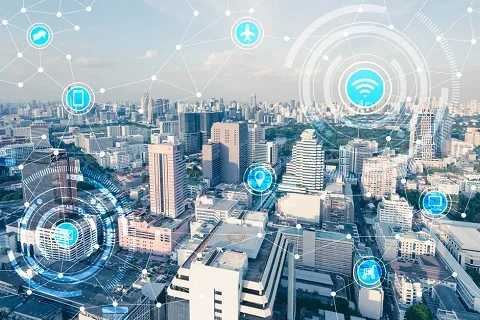***
Utopia

Introduction
The Internet of Things is a thing that really fascinates me, a collection of billions of devices around the world that are connected to the internet, collecting and sharing data and therefore adding a level of digital intelligence to almost anything that would otherwise be simply dumb while also enabling them communicate without human interference and therefore merging the gap between the digital and the physical. However, this understanding of what the Internet of Things is unfortunately just the ideal of what should be and not what is presently obtainable. The IoT is fairly considered to be the next revolution of information technology after the emergence of computers and the internet and so deserves mechanisms which would allow for its optimal development in order to open new paradigms of experience in Information Technology. The IoT industry on the whole is rapidly ascending in investments and number of devices with a reported expected increase of investments from $736.9b in 2015 to $289.9b by the year 2020 and also an expected increase of connected IoT devices from 14.866 billion 30 billion by the year 2030. The Internet of Things however is far from its Utopian state as was experienced by Bob, it is plagued by a whole of problems which so far limited its impact and tamed it growth.
Problem Definition: The Internet of Things and Current Flaws
(a) Lack of Security and Privacy of Data Collected By The Internet of Things:

(b) Inefficiency of Cloud Computing Based IoT Architecture;

The Internet of Things today is mostly based on Cloud Infrastructure because of the levels of speed processing it can afford. However, Communication between devices of the Internet of Things needs to be real time in various scenarios and applications such as in autonomous driving and virtual reality. Cloud based infrastructure falls short of this major requirement hence latency is experienced lasting for up to hundreds of milliseconds a situation not so ideal for the development of the IoT.


For every new paradigm that is achieved, wat really keeps it going is a clear cut line of action, and in this case a business model that can put commercal meanig, purpose and usability into such venture. The IoT rather than providing conveniences has not had such a clear cut business model despite enormous possibil1ities and applications. The IoT industry is however set to be revolutionized by a truly ingenious solution embodied in the project IONCHAIN.
Introducing IONChain

Edge Computing and Decentralized BlockChain Technology: IONChain's Super Combo For the Perfect Internet of Things.
One Device, One Code, One Coin: Integrating IoT Hardware and Infrastructure.

The IONChain Technical Architecture: A New and Better Approach to Value
The value generation process of the IONChain ecosystem is on the other hand divided in four, these are;
- Value Generation: The value generation layer of the IONChain ecosystem is primarily the function of IoT devices connected to the IONChain Network and and their combination with Edge Computing Centers. Each IoT device is a potential mining machine on the IONChain Network and its information can produce IONC tokens. Once value generated is calculated, it is passed on for verification.
- Value Verification: Just like in any consensus model of any other blockchain, value transfer in the IONChain ecosystem requires to be verified by parties interested in such data. Successfully verified data will be passed on for valuation while unsuccessful verification means data being returned invalid.
- Value Evaluation: Verified data is evaluated in order to prevent malicious attacks as double spending.
- Value Confirmation: Successfully verified and evaluated data is confirmed at this stage and passed in order to be transferred.
Value Transfer in the IONChain ecosystem however comprises of five different but equally important layers. These include;
- Application Layer: Devices request access to the IONChain network through this layer which serves also serves as the user interface layer.
- Service Layer: An abstraction of the internal modules in the IONChain ecosystem which adopts a binary based gRPC protocol.
- Protocol Layer: At the protocol layer, IONChain provides a host of various protocols including a consensus protocol, network protocol and a host of others.
- Smart Contract Layer: Smart contracts stand at the very center of the IONChain ecosystem. They are responsible for the interfacing of user requirements and the blockchain thereby enabling users safely access and use data stored on the blockchain. The IONChain smart contract layer is made up of the currency issuance contract, wallet contract and IoT device life-cycle contracts.
- Blockchain layer: The blockchain layer is one that is most core to the IONChain ecosystem and its consensus algorithm is most important. IONChain integrates both the PoS and PoW consensus algorithms into what it calls the IPOS algorithm, a protocol that is ideal for IONChain's IoT solutions.
- Data Storage Layer: IONChain utilizes the BigChainDB as its data storage layer. The BigChainDB offers decentralized storage, is immutable and allows for asset registration and transfer.

Use Cases
Use Case 1: A Smart City Powered By IONChain

Blinkos is a smart city whose entire operations is automated through efficient communication between smart devices of the Internet of Things made possible by IONChain. The traffic lights operate based on data shared with them by cameras, its transport system is run byautonomous cars that collect data in real time and so are efficient thanks to IONChain. Every Sector of the City Blinkos is run by smart devices who collect share and analyze data as made possible by IONChain. Blinkos is therefore very much a classical use case of the possibilities of IONChain.
Case 2: Integration of the IoT in Industrial Processes

Today's industrial processes have become very much automated allowing for the performance of highly complex operations with little or no human effort. With the ability for efficient communication being opened up by IONChain. Shola Inc has therefore implemented IONChain in its manufacturing plant. The various machines communicate securely with each other through the various processes at the same time earning IONC as well as being secure.
Conclusion
While i read through the IONchain whitepaper, i became filled with awe for the brilliant idea put forward by the IONchain team. IONChain is no doubt a project which unlocks the full potentials of the IoT and by removing unresolved issues which revolve around security of data collected by devices of the IoT as well as the ability to share data with other devices. A new paradigm is therefore very much here, thanks to IONChain.
The Team

The RoadMap

For more Information Check out these Sources:
- IONChain Website
- IONChain Bitcointalk Explanation
- IONChain WhitePaper
- IONChain YouTube
- IONChain Twitter
- IONChain Medium
- IONChain LinkedIn
- IONChain GitHub
- IONChain Steemit
- IONChain Telegram
ionchain2018